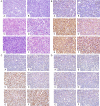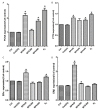Effect of bisphenol a on occurrence and progression of prolactinoma and its underlying mechanisms
- PMID: 27830003
- PMCID: PMC5095312
Effect of bisphenol a on occurrence and progression of prolactinoma and its underlying mechanisms
Abstract
Objective: To investigate the effects of Bisphenol A (BPA) on prolactin (PRL) release, pituitary cell proliferation, prolactinoma formation in estrogen-sensitive Fischer 344 (F344) rats.
Materials and methods: Four-week-old female F344 rats were orally administered with different concentrations of BPA or intraperitoneal injection of estradiol benzoate (estradiolbenzoate, E2) for 12 weeks. Bodyweight, blood RPL level and pituitary weights were observed and recorded. Real-time PCR, western blot and immunohistochemistry analysis were used to detect the mRNA and protein levels of the proliferation markers, including proliferating cell neclear antigen (PCNA), pituitary tumor-transforming gene (PTTG) and its relevant marker ERα. Plasma and urine BPA concentration in patients with prolactinoma and healthy participants were measured as well.
Results: Body weights of the rats treated with BPA were significantly decreased compared with those in the control group. The plasma PRL level and the pituitary weights of the rats were higher than those in the control group after BPA treatment. Compared with the control group, the pituitary mRNA and protein expression levels of PCNA and PTTG were significantly increased after BPA treatment. Moreover, ERα expression level was enhanced by the treatment of BPA in comparison with that of the control group. Finally, the plasma BPA concentration in the prolactin tumor patients was significantly higher than that in the healthy participants.
Conclusion: BPA can significantly promote pituitary cell proliferation and prolactin secretion in F344 rats, which may have impact on the proliferation and secretion of pituitary cell function through the ERα pathway.
Keywords: Prolactinomas; bisphenol A; cell proliferation; estradiol; prolactin secretion.
Figures






References
-
- Glezer A, Bronstein MD. Prolactinomas. Endocrinol Metab Clin North Am. 2015;44:71–78. - PubMed
-
- Gillam MP, Molitch ME, Lombardi G, Colao A. Advances in the treatment of prolactinomas. Endocr Rev. 2006;27:485–534. - PubMed
-
- Schlechte JA. Clinical practice. Prolactinoma. N Engl J Med. 2003;349:2035–2041. - PubMed
-
- Cao L, Gao H, Gui S, Bai G, Lu R, Wang F, Zhang Y. Effects of the estrogen receptor antagonist fulvestrant on F344 rat prolactinoma models. J Neurooncol. 2014;116:523–531. - PubMed
LinkOut - more resources
Full Text Sources
Miscellaneous
